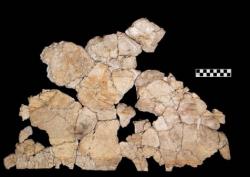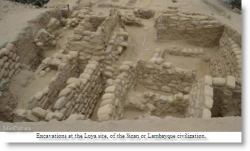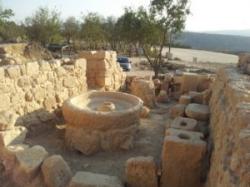INSTITUT SUPERIEUR D'ANTHROPOLOGIE
INSTITUTE OF ANTHROPOLOGY
ONLINE COURSES / COURS A DISTANCE
WINTER TERM : JANUARY 2014
REGISTER NOW
GRECE – 

 Pylos - In recent years a hitherto unknown wall-painting from the Palace of Nestor in Pylos depicting a squadron of ships has been the target of intensive study and reconstruction. The Theran miniature frieze, the Pylos ship frieze, and power in the Mycenaean world”, the three archaeologists will consider two separate but related matters: “1) the extent to which the ship fresco at Akrotiri influenced our attempts at reconstructing its Pylian cousin, and the steps we have taken to avoid allowing the former to determine our perception of the latter; 2) how similar the two works really are. Should we imagine the one as a linear descendent of the other, and, if so, what importance can be attached to such a conclusion? Do they both derive from a common prototype? Or are similarities merely superficial, and the representations unrelated and independent in origin?”
Pylos - In recent years a hitherto unknown wall-painting from the Palace of Nestor in Pylos depicting a squadron of ships has been the target of intensive study and reconstruction. The Theran miniature frieze, the Pylos ship frieze, and power in the Mycenaean world”, the three archaeologists will consider two separate but related matters: “1) the extent to which the ship fresco at Akrotiri influenced our attempts at reconstructing its Pylian cousin, and the steps we have taken to avoid allowing the former to determine our perception of the latter; 2) how similar the two works really are. Should we imagine the one as a linear descendent of the other, and, if so, what importance can be attached to such a conclusion? Do they both derive from a common prototype? Or are similarities merely superficial, and the representations unrelated and independent in origin?”
http://www.archaiologia.gr/en/
PEROU –  Luya -A small group of invaders were planning to start farming on an archaeological site in northern Peru, according to the Ministry of Culture. The ministry said that no major damage was caused at the Luya site, located about 45 minutes outside Chiclayo in Lambayeque region. “No prehispanic building that forms part of the Luya site has been invaded and much less knocked down,” the ministry said. It said the incident was “minor” and the individuals who had invaded the property agreed to leave. The group had reportedly sought to set up on the archaeological site in order to use the land for farming, with authorization from a neighboring community. Archaeologists say the Luya site, of the Sican or Lambayeque culture, includes an important ceremonial center, as well as a series of platforms and terraces dating back some 1,300 years.
Luya -A small group of invaders were planning to start farming on an archaeological site in northern Peru, according to the Ministry of Culture. The ministry said that no major damage was caused at the Luya site, located about 45 minutes outside Chiclayo in Lambayeque region. “No prehispanic building that forms part of the Luya site has been invaded and much less knocked down,” the ministry said. It said the incident was “minor” and the individuals who had invaded the property agreed to leave. The group had reportedly sought to set up on the archaeological site in order to use the land for farming, with authorization from a neighboring community. Archaeologists say the Luya site, of the Sican or Lambayeque culture, includes an important ceremonial center, as well as a series of platforms and terraces dating back some 1,300 years.
http://www.peruviantimes.com/19/group-invades-luya-archaeological-site-in-northern-peru/20715/
ROYAUME UNI - Weald - New evidence of Stone Age and Iron Age activity in the Weald area of Sussex has been revealed by findings from archaeological excavations at a development near Horsham. This new evidence, found at Countryside Properties’ Wickhurst Green in Broadbridge Heath, sheds further light on the theory that the Weald was not the unpopulated wilderness during prehistoric times that it was previously thought to be.“The findings have given us a better picture of when and how the agricultural landscape of the region evolved and shows us that there was in fact a lot more going on in terms of settlement than we realised in the Weald during prehistoric times, especially the Iron Age,” continued Robert, the archaeological consultant for the project Archaeologists from Archaeology South-East, part of UCL, investigated the 46-hectare area of land which lies close to the source of the River Arun.The area forms part of the Weald, which spans much of East and West Sussex, deriving its name from the Old English word for forest.The area retains its wooded nature to this day, however archaeologists revealed indications that the area was cleared of woodland and used for agricultural purposes much earlier than had been previously thought.The earliest evidence of human activity uncovered by the archaeologists was from the hunter-gatherers of the Mesolithic period, in the form of flint used for arrows and blades for hunting. They also discovered what is possibly the earliest Neolithic structure of its type in Sussex – a small square enclosure perhaps relating to the funeral rites and laying out the dead before burial. If indeed this structure was Neolithic, it would be unique within this region, indicating settlement in the area earlier than previously believed. The excavations unearthed some Bronze Age artefacts including an axe, however it was during the Iron Age when the area became a much more established settlement. Extensive evidence from the period was uncovered, including several ‘roundhouses’, which was the main house type of the period, as well as many pieces of pottery from this era and evidence of burial practices. During the Roman period, South East England was occupied extensively and the Weald provided an important mineral resource that was exploited by the Romans. However archaeological evidence shows there were more Roman settlements in the Weald than previously thought. After the Roman period, there is little evidence of Anglo-Saxon settlement on the site, despite Wickhurst Lane deriving its name from Old English and during the Medieval period, Broadbridge Heath remained largely farmland belonging to the manor of Broadbridge. At least two areas of medieval settlement including the foundations of several rectangular ‘hall like’ buildings were also discovered.
http://www.wscountytimes.co.uk/news/local/evidence-of-prehistoric-living-in-the-weald-revealed-after-broadbridge-heath-excavation-1-5694098
CANADA –  Yukon - The frozen remains of a horse more than half a million years old have reluctantly given up their genetic secrets, providing scientists with the oldest DNA ever sequenced. The horse was discovered in 2003 in the ancient permafrost of Canada’s west-central Yukon Territory, not far from the Alaskan border. And although the animal was dated to between 560,000 and 780,000 years old, an international team of researchers was able to use a new combination of techniques to decipher its genetic code. Among the team’s findings is that the genus Equus — which includes all horses, donkeys, and zebras — dates back more than 4 million years, twice as long ago as scientists had previously believed.Previous to this, the oldest genome ever sequenced was of a 120,000-year-old polar bear — no small feat consider that the half-life of a DNA molecule is estimated to be about 521 years. By this reckoning, even under the best conditions, DNA could remain intact for no more than 6.8 million years.
Yukon - The frozen remains of a horse more than half a million years old have reluctantly given up their genetic secrets, providing scientists with the oldest DNA ever sequenced. The horse was discovered in 2003 in the ancient permafrost of Canada’s west-central Yukon Territory, not far from the Alaskan border. And although the animal was dated to between 560,000 and 780,000 years old, an international team of researchers was able to use a new combination of techniques to decipher its genetic code. Among the team’s findings is that the genus Equus — which includes all horses, donkeys, and zebras — dates back more than 4 million years, twice as long ago as scientists had previously believed.Previous to this, the oldest genome ever sequenced was of a 120,000-year-old polar bear — no small feat consider that the half-life of a DNA molecule is estimated to be about 521 years. By this reckoning, even under the best conditions, DNA could remain intact for no more than 6.8 million years.
http://westerndigs.org/700000-year-old-horse-found-in-yukon-permafrost-yields-oldest-dna-ever-decoded/
ISRAËL –  Shiloh - For decades archaeologists have been searching for evidence to support the hypothesis that Shiloh served as a religious center in ancient times. Now, a stone altar dated to the Iron Age—the period of Israelite kings—was accidentally exposed during a dig conducted by an archaeological staff officer of the Civil Administration in Judea and Samaria. The altar was found amid the stones of a wall dated to the Byzantine period. Apparently, the Byzantines removed the altar from its original location in Tel Shiloh and used it to build a structure at the foot of the tel. The discovery is the first tangible evidence that Shiloh was a cultic center prior to and during the First Temple period. Previously, the only evidence for that theory were descriptions in the Bible about the Tabernacle at the time of Joshua and later in the time of Eli the high priest and the prophet Samuel. Until today, archaeologists believed that after the Philistines took the Ark of the Covenant, as described in the book of Samuel, they destroyed the city and Jewish settlement there ended. The altar’s discovery suggests that some Jewish settlement continued there even after the death of Eli the high priest.
Shiloh - For decades archaeologists have been searching for evidence to support the hypothesis that Shiloh served as a religious center in ancient times. Now, a stone altar dated to the Iron Age—the period of Israelite kings—was accidentally exposed during a dig conducted by an archaeological staff officer of the Civil Administration in Judea and Samaria. The altar was found amid the stones of a wall dated to the Byzantine period. Apparently, the Byzantines removed the altar from its original location in Tel Shiloh and used it to build a structure at the foot of the tel. The discovery is the first tangible evidence that Shiloh was a cultic center prior to and during the First Temple period. Previously, the only evidence for that theory were descriptions in the Bible about the Tabernacle at the time of Joshua and later in the time of Eli the high priest and the prophet Samuel. Until today, archaeologists believed that after the Philistines took the Ark of the Covenant, as described in the book of Samuel, they destroyed the city and Jewish settlement there ended. The altar’s discovery suggests that some Jewish settlement continued there even after the death of Eli the high priest.
http://www.algemeiner.com/2013/11/20/shiloh-altar-biblical-archaeology-provides-evidence-of-ancient-religious-center/